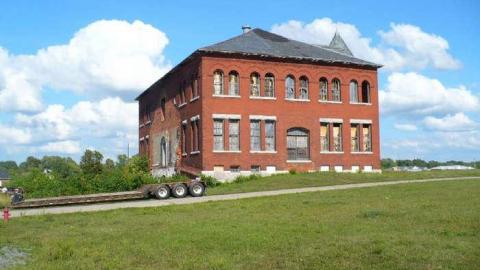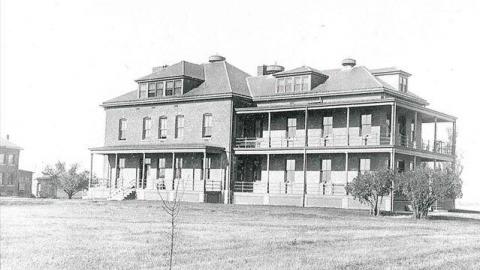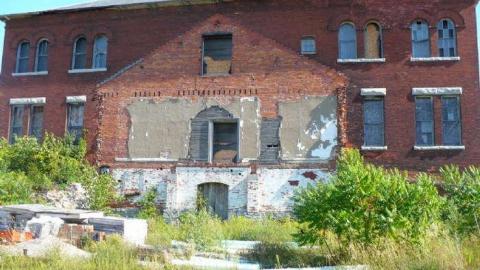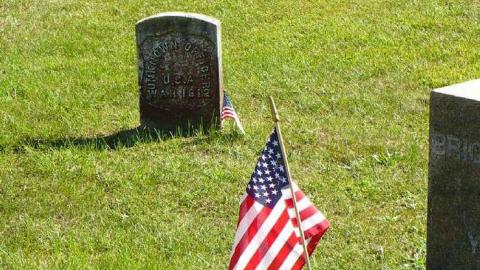About this location
Yes I realize this is not in Ontario, or even Canada, but with the kind permission of Mr. OAP, I am posting this location due to its important link with the history of our country and because of its fairly close proximity to our borders. The history and influence, as well as the sad abandonment of this location make it a worthy visit for explorers from the Kingston area.
Many parts of the Madison Barracks complex are being re-purposed and saved as condos or businesses, while others remain in a terrible state of disregard.
Please see the links below for more details, the photos speak for themselves. This history is taken from http://www.marinainnny.com/history-of-madison-barracks: For almost two centuries, the limestone and brick structures of Madison Barracks in Sackets Harbor, N.Y. have helped to protect and preserve America. Founded because of the area's strategic importance during the War of 1812, the Barracks has aided our country in every war, from the War of 1812 to World War II. It has also served as a frontier post, military depot, hospital and training center for both civilians and the military. At times, the Barracks bustled with activity and life; at others, it lay empty and quiet. Through the years the sturdy buildings, tree-lined streets, and beautiful green parade grounds lay in silent testimony to the men that built them. Today, despite years of abandonment and despair, the Barracks is once again bustling with activity. In the words of General Jacob Brown (1819) "they will endure for ages, a monument of the folly and the wisdom of those by whom they were erected". No visitor today can help but feel respect and awe for this historic place which so many years served so many.
In 1815, five companies of the Second Infantry Regiment arrived at Sackets Harbor and were immediately put to work; the construction of Madison Barracks had begun. In spite of several budgetary setbacks, the work was well under way when President James Monroe came to observe the progress. On its completion, Madison Barracks was considered to be one of the nation's best military posts and a key America's northern defense. The original Barracks consisted of four one story limestone structures of which two of these,"Stone Row" still stand. The stone had been cut from the cliffs along the lakeshore and the total construction cost was $150,000.00.
By 1820, 30% of Sackets Harbor's population was housed at the Barracks. General W.J. Worth began a program of repairs and construction in 1838. New buildings constructed at that time were a stone commissary, a quartermaster's storehouse, an ordinance building, a guard house, and a hospital. It was in this hospital that Dr. Samuel Guthrie invented Chloroform and the first operation making use of an anesthetic was performed. Dr. Guthrie also discovered the percussion ignition powder while living in Sackets Harbor and carried on experiments in the hospital until his death in 1843. As a sideline, Dr. Guthrie took the skeletal remains of unknown casualties and prepared them for use in medical schools and doctor's offices through out the United States.
In 1848, units of the 4th Infantry Regiment returned from the Mexican War and were stationed at Madison Barracks. One of the new arrivals was a young 2nd Lieutenant named Ulysses S. Grant. Grant was remembered as being generally withdrawn except for when he raced his horse to Watertown most Saturday evenings to play checkers. The building Grant lived in, on Old Stone Row, has been rehabilitated into extended stay apartment units. Grant and the entire garrison left in 1852, and once again, Madison Barracks lay empty. Grant returned to the Barracks for a short time just prior to the start of the Civil War. The outbreak of the War Between the States however revived the camp which reopened in October 1862. Throughout the war, the barracks was used as a depot and rendezvous point. At the end of the war, many units served at the Barracks, but the days of the Barracks seemed to be numbered.
There was a movement in the government at this time to begin shutting down posts to cut costs, and a permanent closing of the Barracks was advocated by the General-In-Chief of the Army. The death blow seemed to call on November 6, 1876, when the eastern half of the Officer's quarters burned down, (OLD STONE ROW EAST WING) and the general urged abandonment of the partially destroyed out post. Two villagers, Colonel Camp and Congressman George Bagley, saved the Barracks by going directly to President Grant who, out of sentiment, intervened and saved the post. Madison Barracks received a new lease on life, and a period of renewed activity followed.
Starting in 1887, a new administration building, stone storehouses, Officers quarters (Officers Row), and a second story was added to the original limestone barracks (Old Stone Row). The iron fence which once belonged to Buckingham Palace was taken to Madison Barracks and placed around the military cemetery. Today the military cemetery located on Dodge Avenue is the home of this historic fence.
The post was expanded in 1892 and 1895 to its present day 115 acres. A new mess hall, barracks, a stone water tower, and several other buildings date from this period of time. Also in 1895, the army purchased the Stony Point Target Range consisting of 868 acres 16 miles away from Madison Barracks. This was enlarged in 1910 and renamed Pine Plains Camp with over 17,000 acres, which was to become the present day army installation of Fort Drum, the home of the 10th Mountain Division. Despite all this expansion, the advocates of consolidation appeared once again and urged abandonment of the Madison Barracks. The citizen protest from Sackets Harbor managed to preserve the Barracks a second time; on May 28, 1913, the village celebrated the centennial anniversary of the battle of Sackets Harbor. A monument was erected, the principal address and dedication was given by Assistant Secretary of the Navy Franklin D. Roosevelt. Today the monument remains in its original location on the grounds of the NYS Battlefield site.
Throughout the years, many have served at Madison Barracks in Sackets Harbor, which is now one of the fourteen upstate NY communities designated a NYS Heritage Area.
Fort Volunteer, (circ, 1811) where General Pike fought the British in the war of 1812 is the only remaining and visible fortifications left in Sackets Harbor. Re-named Fort Pike after the death of General Pike, in the attack of York (Toronto, Canada) is owned by the village of Sackets Harbor and plans to create a green space interpretive park are underway.







12 years ago
That's awesome Timo. Great job capturing history.